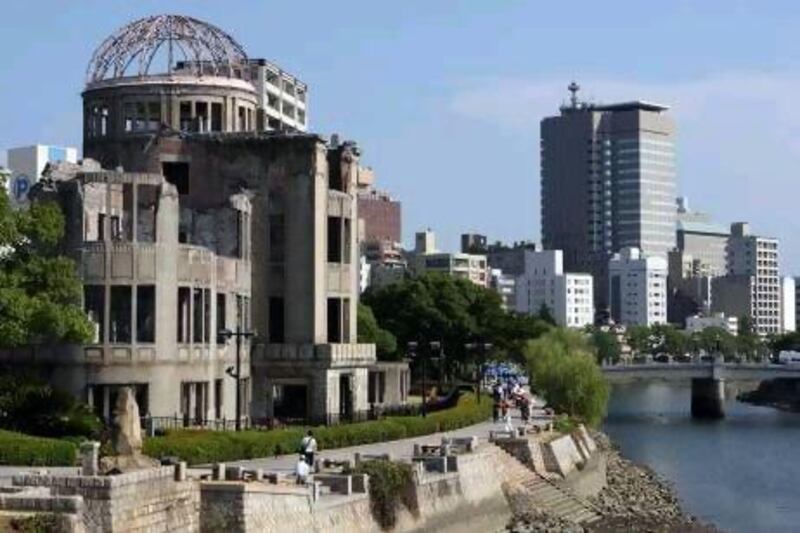Why Hiroshima?
When an event of the magnitude of August 6, 1945, happens, it's hard for a place to ever shake off the association. But a visit to modern-day Hiroshima shows that even if the name evokes images of nuclear annihilation, it's possible to not only survive catastrophe, but thrive into the future. The city, located at the western end of Honshu, Japan's biggest island, is today as healthy and happy as any in the country, famous for its food, scenery and love of sports. In truth, unless they wanted you to, you'd never know that the world's first nuclear bomb was dropped here. And for many people in today's Japan, the city's ability to rise again gives hope to the rest of the country after the great earthquake last year.
A comfortable bed
As you'd expect of a city of 1.2 million people, Hiroshima isn't short of accommodation options. Few are better positioned than the Rihga Royal (www.rihga.com; 00 81 82 502 1121), right in the city centre, a few minutes' walk away from the Memorial Peace Park, and right above some of the best shopping malls in town (double rooms start from ¥16,000 [Dh704] per night). Most of the big hotels are represented in Hiroshima, the pick of which is the Sheraton (www.starwoodhotels.com; 00 81 82 262 7111); double rooms from ¥16,000 per night. The hotel is a short walk from the train station.
Find your feet
The Hiroden tram network is a quick and clean way to get around town, with stops near most of the city's tourist attractions, including Chuo Park, home to Hiroshima Castle. Like most castles around Japan, it is a reconstruction, but an honest one nonetheless, which looks spectacular in spring when the cherry blossom ignites in the park's 350 trees. Meanwhile, in the north-east of the city, also on the tram line, there's Shukkeien, a picturesque garden, adjacent to the equally beautiful Prefectural Art Museum.
The extreme end of the line will bring you to a port, where you can hop on the JR ferry (www.jr-miyajimaferry.co.jp) to make the 10-minute journey to Miyajima. One of the three official "most scenic views in Japan", it's the site of a Shinto shrine, a gigantic red torii gate that dips its toes into Japan's inland sea.
Meet the locals
Hiroshima's residents are famously gregarious, and if you don't mind fighting for elbow room, then the best place to meet them is Okonomi-mura (www.okonomimura.jp), a hodgepodge of 25 food stalls spread over three floors. As well as having the chance to chat to the locals - those under 30 will generally speak more English - you'll have the chance to try Hiroshima's famous okonomiyaki, often misleadingly referred to as Japanese pizza. It's actually more like an omelette with almost a dozen ingredients, all fried together in layers and served hot from the communal grill in front of the diners. Hiroshima and Osaka constantly bicker about whose version is best, but the former has a good deal more vegetables and less mayonnaise, so is at least comfortably more virtuous.
Book a table
Take the tram to the Danbara stop to sample traditional dining at Tosho (www.toufu-tosho.jp), a tofu specialist. With set menus starting from ¥3150 (Dh139), it's not cheap, but the tofu is homemade and the waitresses look wonderfully prim in their kimonos.
Oysters are also big business here. For a treat, head to the Kanawa (www.kanawa.co.jp), the floating oyster boat, to sample some of the fresh fare - raw, fried or in half a dozen other styles. Lunches start from ¥3,100 (Dh135; dinners are considerably more expensive). The best time of year to visit is October to March.
For something completely different, the last weekend of October hosts a citywide food festival, when stalls pop up everywhere, selling all manner of seasonal treats.
Shopper's paradise
Hiroshima's shopping malls are mostly hidden underground. The most central is the Motomachi Pacela double mall, with hundreds of stores selling everything from sushi to designer handbags.
What to avoid
Tourists with loud mouths, big opinions and a narrow view of history - particularly when visiting any of the war memorials.
Don't miss
The Hiroshima Memorial Peace Park: there are other reasons to visit, but it's impossible not to take in the terrible events the city endured as the Second World War drew to its grisly end. It's thought that 30 per cent of the city's population died instantly when the atom bomb was dropped - 80,000 people, or four times the number of lives lost during last year's earthquake and tsunami. A visit to the park, though often harrowing, is essential to the understanding of what happened before, during and after Little Boy (the code name for the bomb) fell. The museum at the centre of the park is loaded with information and photographs, all presented in admirably neutral prose; the aim here isn't to shape opinions but to educate the million visitors who visit each year about the dangers of nuclear conflict.
Also in the park is the A-bomb Dome, a building preserved as it was the day the sky exploded; and a memorial to the thousands of children who were killed through radiation poisoning. It's never easy to be there, but the entire park is a Unesco World Heritage Site - surely few places deserve the title more.










